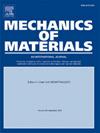An FFT based chemo-mechanical framework with fracture: Application to mesoscopic electrode degradation
IF 3.4
3区 材料科学
Q2 MATERIALS SCIENCE, MULTIDISCIPLINARY
引用次数: 0
Abstract
An FFT based method is proposed to simulate chemo-mechanical problems at the microscale including fracture, specially suited to predict crack formation during the intercalation process in batteries. The method involves three fields fully coupled, concentration, deformation gradient and damage. The mechanical problem is set in a finite strain framework and solved using Fourier Galerkin for non-linear problems in finite strains. The damage is modeled with Phase Field Fracture using a stress driving force. This problem is solved in Fourier space using conjugate gradient with an ad-hoc preconditioner. The chemical problem is modeled with the second Fick’s law and physically based chemical potentials, is integrated using backward Euler and is solved by Newton–Raphson combined with a conjugate gradient solver. Buffer layers are introduced to break the periodicity and emulate Neumann boundary conditions for incoming mass flux. The framework is validated against Finite Elements the results of both methods are very close in all the cases. Finally, the framework is used to simulate the fracture of active particles of graphite during ion intercalation. The method is able to solve large problems at a reduced computational cost and reproduces the shape of the cracks observed in real particles.
基于FFT的断裂化学力学框架:介观电极降解的应用
提出了一种基于FFT的微尺度化学力学问题(包括断裂)模拟方法,特别适用于电池嵌入过程中裂纹形成的预测。该方法涉及三个完全耦合的场:浓度场、变形梯度场和损伤场。将力学问题设置在有限应变框架中,并采用傅里叶伽辽金法求解有限应变非线性问题。损伤模型采用应力驱动相场断裂。在傅里叶空间中,利用共轭梯度和特别预条件解决了这一问题。化学问题用第二菲克定律和基于物理的化学势建模,用后向欧拉积分,用牛顿-拉夫森结合共轭梯度求解器求解。引入缓冲层来打破周期性并模拟入射质量通量的诺伊曼边界条件。对框架进行了有限元验证,两种方法的结果在所有情况下都非常接近。最后,利用该框架模拟了石墨活性粒子在离子插入过程中的断裂。该方法能够以较低的计算成本解决大问题,并能再现真实颗粒中观察到的裂纹形状。
本文章由计算机程序翻译,如有差异,请以英文原文为准。
求助全文
约1分钟内获得全文
求助全文
来源期刊

Mechanics of Materials
工程技术-材料科学:综合
CiteScore
7.60
自引率
5.10%
发文量
243
审稿时长
46 days
期刊介绍:
Mechanics of Materials is a forum for original scientific research on the flow, fracture, and general constitutive behavior of geophysical, geotechnical and technological materials, with balanced coverage of advanced technological and natural materials, with balanced coverage of theoretical, experimental, and field investigations. Of special concern are macroscopic predictions based on microscopic models, identification of microscopic structures from limited overall macroscopic data, experimental and field results that lead to fundamental understanding of the behavior of materials, and coordinated experimental and analytical investigations that culminate in theories with predictive quality.
 求助内容:
求助内容: 应助结果提醒方式:
应助结果提醒方式:


